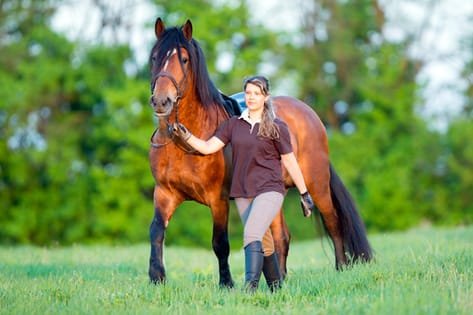Buying a horse is a big decision and an exciting one—but it also comes with responsibility.
While it’s easy to fall in love with a pretty face or a friendly nicker, making a smart decision means looking beyond first impressions. A horse might look healthy and well-behaved, but there could be hidden problems that only a careful assessment—and a vet check—can reveal.
One of the most important steps in the buying process is the pre-purchase exam (also called a vet check). This exam can help you avoid costly and heartbreaking mistakes. In this article, we’ll walk through what to look for when buying a horse, and what’s involved in a pre-purchase exam so you can feel confident in your decision.

Step 1: Evaluate the Horse Before the Vet Comes
Before you even schedule a vet check, you can do your own informal assessment of the horse. Here’s what to pay attention to:
General Health & Appearance
- Is the horse at a healthy weight?
- Is the coat shiny and clean?
- Are the eyes clear and bright?
- Do the hooves look strong and well-maintained?
Temperament
- Is the horse calm or nervous?
- Does it stand quietly to be groomed or tacked up?
- How does it behave around other horses and people?
Under Saddle
- Is the horse responsive to cues?
- Does it move soundly at the walk, trot, and canter?
- Is it suitable for your skill level and riding goals?
Tip: Always try to watch the horse being ridden and ride it yourself if you feel comfortable—or bring a trusted trainer to help assess its behavior and training.
Step 2: Schedule a Pre-Purchase Exam
Once you think you’ve found the right horse, don’t skip the pre-purchase exam. This is a full-body health and soundness check performed by an equine veterinarian, ideally someone not affiliated with the seller. The exam helps reveal any current or potential health problems that could affect the horse’s performance or care.
What’s Included in a Pre-Purchase Exam?
Pre-purchase exams can vary depending on your budget, the horse’s intended use, and how detailed you want it to be. They usually fall into two categories: basic and comprehensive. Here’s what vets typically look for:
1. Medical History & Observation
- Discuss the horse’s past injuries, treatments, or known conditions
- Evaluate body condition, coat, eyes, and overall demeanor
2. Lameness and Soundness Exam
- Flexion tests (bending joints to check for pain or stiffness)
- Watching the horse move at walk, trot, and canter on different surfaces
- Lunging in both directions to spot uneven gaits or favoring limbs
3. Teeth and Mouth
- Check for dental issues that could affect eating or accepting the bit
4. Skin and Hoof Health
- Inspect hooves for cracks, thrush, abscess history, or signs of laminitis
- Check for skin conditions or infections (like rain rot or dermatitis)
5. Heart, Lungs, and Vitals
- Listen to the heart and lungs for any murmurs, irregular rhythms, or breathing issues
- Take temperature, pulse, and respiration
6. Optional Add-Ons
- X-rays: Helpful for competition horses or long-term investment
- Ultrasounds: Used for checking tendons, ligaments, or reproductive health
- Bloodwork: Screens for infections, drug use, or hidden illness
Why It Matters
Some horses have manageable conditions (like mild arthritis), but others may have long-term problems that will affect rideability or require expensive care. The pre-purchase exam:
- Gives you peace of mind
- Helps prevent surprises after purchase
- Offers leverage in negotiation
- Helps match the horse’s abilities to your expectations
It’s not about finding a “perfect” horse—it’s about making an informed choice.
Questions to Ask After the Exam
Once the exam is complete, talk to the vet and ask:
- Is the horse suitable for my intended use?
- Will it need special care or treatment?
- Is this horse a good long-term match for my riding level and goals?
Sometimes the vet might say the horse is fine for light riding, but not recommended for jumping or heavy competition. That kind of insight can save you time, money, and stress down the road.
Red Flags to Watch For
While some issues are manageable, others can be deal-breakers depending on your plans. Be cautious if the vet finds:
- Chronic lameness
- Signs of past injuries that never healed
- Neurological symptoms
- Breathing issues like roaring or heaves
- Hidden medications in the horse’s system (found through bloodwork)
Final Checklist Before You Buy
✔ Have you tried the horse in person (ridden or handled)?
✔ Have you asked the seller questions about health, training, and temperament?
✔ Did you complete a pre-purchase vet exam?
✔ Do you feel comfortable and confident with your decision?
Final Thoughts
Buying a horse should be exciting—but also thoughtful. Taking the time to do a full pre-purchase evaluation helps protect your investment, your safety, and your long-term happiness as a horse owner. Remember: it’s better to walk away from a horse that doesn’t pass the vet check than to buy a horse you’ll struggle to care for.

